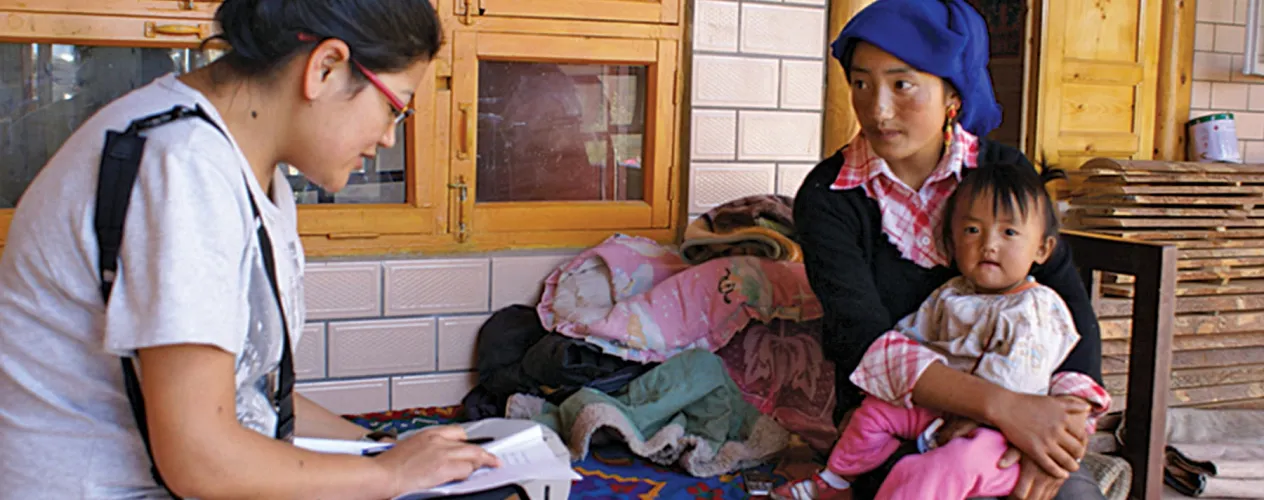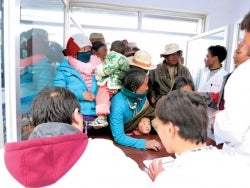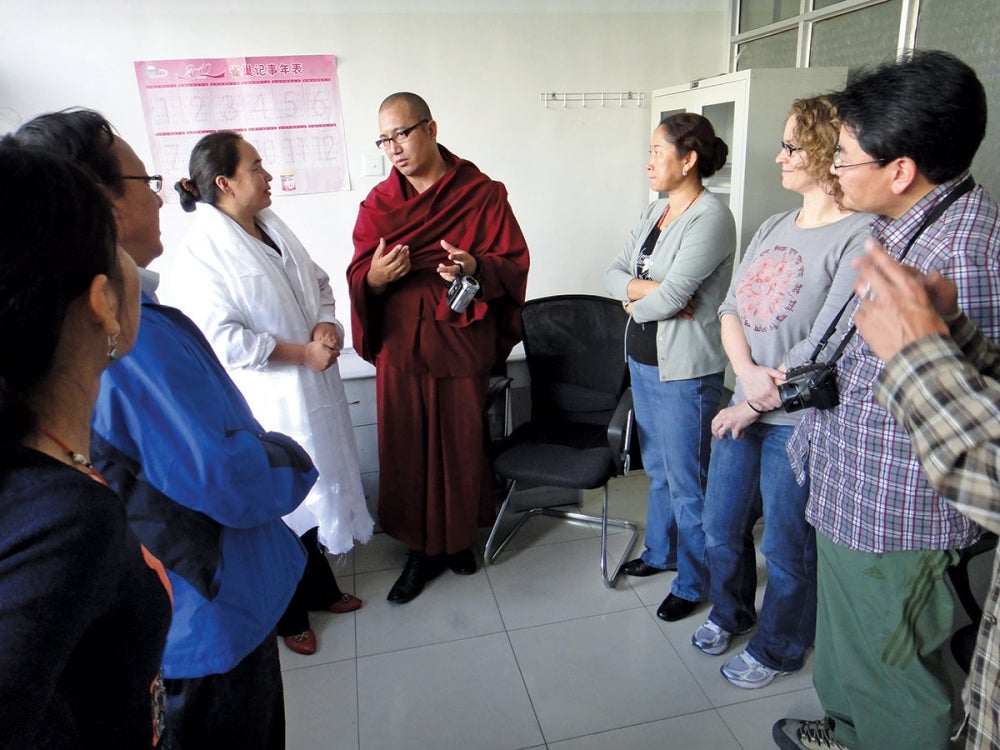Delivering for Women in Rural China
A decade-long partnership between FSPH and colleagues in Tibet has helped more women give birth in safe settings.

NATIONALLY, CHINA’S EFFORT OVER THE LAST SEVERAL DECADES to reduce maternal mortality rates by promoting hospital deliveries has been highly successful. From 1990 to 2011, maternal mortality rates declined an average of 5.7 percent per year, far greater than the average declines for low- and middle-income countries over the same period.

But maternal mortality rates have remained high in rural, disadvantaged and ethnically diverse parts of the country, particularly in western China, where hospital delivery rates continue to be low. “This suggests that a single approach to lowering maternal mortality might not be sufficient for a country as diverse as China,” says Dr. Jessica Gipson, associate professor in the Fielding School’s Department of Community Health Sciences. For nearly a decade, Gipson has joined with FSPH colleagues in an ongoing collaboration with colleagues in the Tibetan region of China to implement and study an alternative approach. The collaboration has produced important insights into barriers faced by women giving birth in rural and lower-income communities, and ways in which complex reproductive health problems in such communities can be effectively addressed.
Gipson and other FSPH researchers — including Drs. Anne Pebley, Alina Dorian, Corrina Moucheraud and May Wang from the school’s faculty, along with recent doctoral graduate Tabashir Nobari (PhD ’16) — have joined with the Qinghai University Tibetan Medical College (QUTMC), led by Dean Lhusham Gyal and Kunchok Gyaltsen (PhD ’10), in evaluating the innovative reproductive health programs QUTMC has implemented in recent years. The longtime partnership also involves teaching: Gyaltsen, a Tibetan medical doctor and Buddhist monk, completed his doctorate at FSPH and has since sent 10 Tibetan medical students to train at FSPH for periods ranging from three months to a year. Funding for the training came from FSPH’s Bixby Center on Population and Reproductive Health and the Tibetan Healing Fund, a nonprofit humanitarian organization Gyaltsen helped establish to improve primary care and education for rural Tibetan women and children.
The collaboration began after the Tibetan researchers had found that more than 90 percent of the rural women in Tibet’s Qinghai Province were delivering at home rather than in a hospital for reasons that included transportation difficulties, lack of accommodations in the hospitals for accompanying families, the cost of hospital delivery, a shortage of trained community birth attendants, and language and cultural barriers. “This meant that in cases where women needed assistance with delivery, they weren’t getting it in a timely fashion,” Gipson notes.

Based on those findings, Gyaltsen and his Tibetan research colleagues worked with local health authorities to implement a three-level intervention. At the county level, they launched the Tibetan Birth and Training Center (TBTC), where women who wouldn’t normally deliver in a hospital could easily access highly skilled and culturally relevant care. At the community level, they established a midwife-training program to meet the needs of women who chose to deliver at home. And at the individual level, the birth center prepared midwives, health workers and village residents to serve as peer educators on maternal and child health in their communities.
The TBTC, which opened in 2009, features an all-female staff of Tibetan obstetricians and midwives, modern facilities, and home-like suites for women and their families. “This was a new option for the mostly Tibetan population,” Gipson says. “The women could stay with their families in suites that included cooking facilities, bathrooms, and traditional Tibetan beds heated by stoves, which was what they were used to at home — but in an environment with skilled birth attendants.” According to Gyaltsen, more than 5,000 babies have been delivered at the center and thousands of women have received health education.
The FSPH and Tibetan research team found the three-level approach to be highly effective in increasing access to and utilization of the formal delivery services, as well as in changing perceptions about maternal care and delivery options among the target population. “Tibetan nomadic women face challenging reproductive health problems,” Pebley says. “This research is essential in assessing their needs and evaluating whether programs to meet these needs actually work. In addition, the innovative solutions and experience in improving maternal and reproductive health in rural Tibetan communities provide important models of how to improve health in other poor rural populations worldwide.”
For Gipson, the collaboration is part of a larger body of work on sexual and reproductive health issues in low-income global settings. “I’m particularly interested in identifying how gender, gender norms, and socio-political systems influence decisions about sexual and reproductive health, and how public health programs can best support these decisions and optimize the health of individuals and families,” Gipson explains.
It’s an interest that dates to her time as an undergraduate anthropology student at UCLA, when she conducted an independent study in Mexico with one of her professors, a medical anthropologist; Gipson then took Community Health Sciences 100, a Fielding School course, and ultimately enrolled in a joint MPH program with the Peace Corps, cementing her interest.
Since then, Gipson has spent significant time in disparate settings — in the Philippines, Bangladesh and Malawi, as well as China — examining ways in which culture, politics and gender norms affect the reproductive freedoms of women and men. Among other things, she has studied the role of couple dynamics in contraceptive use and how public health interventions can assist couples in achieving their desired fertility, along with strategies to ensure that women and couples can have children if and when they choose to do so. Gipson is also involved in research into how a new male contraceptive gel could expand the range of available contraceptive options and change the way people think about contraception and the politics of reproductive health.
Much of Gipson’s work incorporates interviews and small-group discussions in which members of a community discuss how they are affected by these issues, and how they would like things to change. “It’s important to identify the different domains in which men and women may have more or less power, and what can influence that,” Gipson says. “Certainly there needs to be a continued focus on women’s rights: Improving the status of women is one of the best ways of ensuring continued development and economic growth, particularly in lower-resource settings. However, ultimately, progress in addressing many persistent sexual and reproductive health challenges hinges on positively engaging men — both for their health and as supportive partners.”

Kunchok Gyaltsen, PhD ’10 (center), a Buddhist monk and Tibetan medical doctor, helped to establish the Tibetan birth and training center, where rural Tibetan women who wouldn’t normally give birth in a hospital can easily access highly skilled and culturally relevant care. Dr. Jessica Gipson (second from right) is part of an FSPH group that has spent nearly a decade collaborating with Gyaltsen and his Tibetan colleagues.